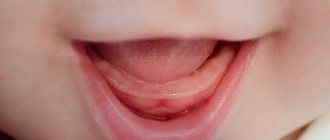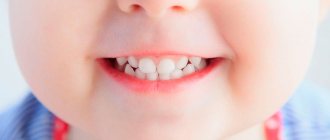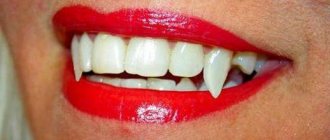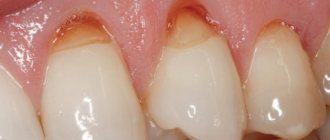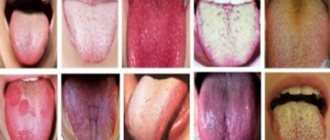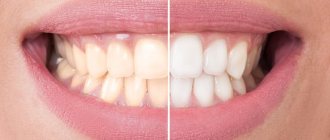Causes of caries development in young children
There are two reasons contributing to the development of caries:
- plaque;
- frequent consumption of sugar (sucrose, glucose in combination with fructose, is especially dangerous).
Often children do not like to brush their teeth or do it incorrectly. As a result, plaque is deposited in areas of the teeth that do not clean themselves when chewing (in fissures, near the gums). Demineralization and softening of the enamel occurs, and subsequently caries.
Young children mainly eat liquid or pureed foods. Active chewing does not occur, and tooth surfaces are not cleaned.
In children, enamel and dentin have a structure that is unusual for adults: mineralization in the tissues is imperfect, teeth are in the process of development. Due to the low density of enamel and its insufficient mineralization, caries in young children develops frequently and is quite severe. A large number of teeth are involved in the process, and circular caries occurs - when the lesion spreads around the neck of the tooth, peeling off the crown from it.
Lack of vitamins, chronic and hereditary diseases also provoke caries in children.
If a child’s teeth are spoiling, what to do?
It is important for parents to understand that enamel is the main protection, the stability and structure of which depends on hereditary factors and on the saliva that washes the surface of the teeth. If the composition of saliva is disturbed because the child does not receive enough vital nutrients and minerals, this can lead to the formation of permanent plaque on the teeth. Even with systematic and thorough cleaning, it is impossible to get rid of such plaque forever, since it will appear again and again.
If a child’s teeth deteriorate due to the disturbed composition of saliva, then this problem can be solved by adjusting the diet. The menu should be balanced. It must contain foods rich in iron, calcium and other minerals that strengthen tooth enamel: hard cheese, sesame seeds, bran, feta cheese, milk, cottage cheese, herbs, legumes. Foods rich in phosphorus are very useful: fish, cottage cheese, cod liver, shrimp, squid, beets, carrots.
However, parents’ independent actions cannot always bring results. If your child’s teeth continue to deteriorate, then it is worth making an appointment with a pediatric dentist, who will offer effective treatment methods and help stop the destructive process.
Why should caries in primary teeth be treated?
It is a mistake to think that baby teeth do not require treatment. Tooth decay is a disease caused by the growth of bacteria in the mouth. It weakens the immune system, and this leads to frequent illnesses in the child.
Tooth irritation from food forces the child to spare the affected side when chewing, which can disrupt the bite for life.
Consequences of refusing treatment:
- Maintaining a focus of chronic infection. From the oral cavity, bacteria can spread to the ENT organs, the digestive tract, the lungs and even lead to sepsis.
- Violation of the formation of permanent teeth. Unrecognized deep caries has a negative effect on the rudiments of permanent teeth. As a result, they grow up weakened or already affected by caries.
- Violation of the integrity of the dentition. In the absence of timely treatment, children quickly develop pulpitis. Such teeth are removed, the integrity of the dentition is damaged, and the bite changes.
A child’s teeth are deteriorating - what to do?
A child’s teeth deteriorate: reasons.
What factors worsen the health of baby teeth?
If a child’s teeth deteriorate, what should I do?
Unfortunately, many children have dental problems. As a rule, this causes trouble not only for parents, but also for the baby himself. For example, if a child’s teeth are deteriorating, then parents must make an effort to find the cause and eliminate it in time.
How is baby teeth treated?
Treatment of caries in children is carried out only by a pediatric dentist, since the structure of a child’s teeth differs from that of an adult. The doctor must provide psychological comfort for the little patient, otherwise the next visit will be problematic.
The treatment technique has some differences:
- superficial caries can be treated using the silvering method or the application of special remineralizing and fluoridating pastes without the use of a drill;
- when treating moderate caries, special materials and fillings that are safe for children are used; with deep caries and the development of pulpitis, tooth extraction is often resorted to.
Stages of pathology development
Such destructive processes, affecting children's enamel, develop in stages:
- At first, accumulations of dirt are visible on the enamel, yellowish spots gradually appear on the front teeth, and over time they begin to darken. There is an unpleasant odor from the mouth, which signals the beginning of putrefactive processes,
- the child’s enamel sensitivity to hot and cold food and drinks increases, distinct foci of destruction appear in the form of black spots,
- rotting penetrates into the deeper layers, causing severe pain, which is especially acute under mechanical influence, for example, when pressing,
- the lesion reaches the nerve endings, and the pain subsides. Don't hope that everything will work out. Pathological processes continue to develop, spreading to the root, as a result of which it can be completely lost.
If the problem is not solved in time, the child may lose teeth.
It is important to understand that at the initial stage it is quite possible to solve the problem. But if you delay treatment, you can easily miss the opportunity to save the tooth.
Prevention of caries in children
- Oral hygiene. From the moment the first tooth erupts, the mother should use a soft cloth wrapped around her finger to clean it of plaque every day. When the oral cavity is filled with teeth, the child can do this on his own with a brush. From 3-4 years old, the use of children's pastes (gel-based) is allowed. It is important to teach your child to brush their teeth twice a day, explaining that it is correct to make vertical movements with the brush, not horizontal ones.
- Diet with restriction of sweet foods. It is important to ensure a complete diet, a sufficient amount of microelements and vitamins in food.
- Use fluoride-containing toothpastes as recommended by your dentist.
- Visit the dentist at least once every six months.
What are the dangers of putrefactive processes if they are not treated?
When it comes to treating a small child, it should be understood that destruction very quickly spreads to the internal structures of the tooth. In addition, the processes of decay contribute to the development of inflammatory processes in the surrounding tissues, the appearance of suppuration. If you ignore the problem and miss the precious moment when teeth can still be saved, it is likely that you will have to face very serious complications, including an abscess, severe intoxication of the body and damage to vital organs.
“My daughter has had very bad teeth since birth, just like me. Apparently it was passed on genetically. Almost from the very appearance of the first incisors, we have been constantly struggling with caries. At the same time, I personally make sure that she brushes her teeth twice a day, I don’t give her sweets, but, as they say, you can’t smear genes with your finger. And recently we discovered rot! The doctor immediately took an X-ray - fortunately, they managed to notice it in time, and the destruction did not reach the inner layers. After this, the doctor cleaned us, prescribed special gels and rinses, and put in a temporary filling. A course of antibiotics was prescribed. I’m very worried that there won’t be a relapse.”
Angelina, Saratov, from correspondence on the 24satoma.ru forum
Black teeth look rather unaesthetic and can lead to complexes in a child.
In addition to everything said above, rotten black teeth look extremely unaesthetic, and often become the main reason for the development of serious psychological complexes in a child. The visual picture is unpleasant both for the patient himself and for those around him. In order not to bring the disease to such an advanced stage, when the first suspicious spots appear on the child’s enamel, you should immediately show it to a pediatric dentist.
What is bottle caries?
There is another type of childhood caries - bottle caries. It occurs in children after the eruption of baby teeth, when the baby is breastfed or bottle-fed. This disease usually occurs as a result of feeding a child before bedtime. While he sleeps, bacteria begin to multiply in his mouth.
Often this form of carious process affects the cervical area. Gradually, caries spreads along the entire circumference of the crown. First, white spots appear, then they darken and destroy dentin. The child constantly cries, especially during meals, sleeps poorly and tries to refuse food. This indicates increased sensitivity of the enamel. Left untreated, it can lead to premature loss of baby teeth.
How to treat the problem
The solution to the problem under consideration requires an integrated approach. Before starting symptomatic treatment, it is necessary to identify and eliminate the root cause of the development of putrefactive processes. So, the generalized diagram looks like this:
- X-ray examination: allows you to assess the degree of development of the lesion and the condition of the internal structures. Based on the complete clinical picture, the specialist draws up an optimal treatment plan, if there is still a chance to save the teeth,
- antiseptic treatment of the oral cavity, which usually uses drugs such as Chlorhexidine and Metrogyl. The patient may also be prescribed antiseptic gels and rinses with an anti-inflammatory effect, professional cleaning of plaque and hard deposits,
- recovery: Antibacterial therapy is usually used to ensure that the infection is eliminated. The necessary antibiotics can only be prescribed by a specialist, and the independent use of any drugs is strictly prohibited. In order to restore the condition of the oral cavity, all carious cavities are cleaned, filled and the enamel is coated with fluoride-containing varnishes,
- removal of severely damaged teeth: when destructive processes penetrate the pulp and root, the diseased tooth is removed and replaced with an artificial crown.
As you already understand, it is extremely important to treat baby teeth, because otherwise problems with permanent teeth cannot be avoided. A rotten tooth is an open source of infection, which can provoke the development of serious problems with the body as a whole. And you should not try to solve the problem yourself, since only professional treatment by a dentist can guarantee the desired result.
- Ulitovsky S.B. Causes of non-carious lesions of teeth, 2001.
Treatment
Dental treatment for children is the key to good health. Modern technologies are designed for therapy of children of different ages. Toddlers need a special approach. Their treatment should be as safe and painless as possible, so as not to traumatize the psyche. Traditional methods include:
- Silvering when the solution is applied to pathological areas of the enamel. This forms a protective healing film.
- Application of mineral mixtures is carried out for superficial lesions.
- Deep fluoridation of enamel. This method is effective for minor lesions. This long-term mineral supplement has a beneficial effect on crowns.
- Removing affected areas using special tools. The cleaned areas are treated with antiseptic preparations and sealed with cement mortar, which is enriched with fluorides.
- Therapy with laser beams.
- For deep caries, depophoresis is performed. The dentist rinses the root canals with copper-calcium hydroperoxide.
- Applying gel to dark spots after plaque removal in children aged 2-3 years. It eats away the darkened area. A quickly hardening polymer is applied to clean areas, which hardens under the influence of a special lamp.
- Opening a carious cavity with a drill. The technique is used in cases of advanced caries. The dentist removes the purulent contents, fills the clean unit with a calcined mixture, and installs a filling for a certain time.
- Removal of pathogenic microorganisms by ozonation of enamel.
Unhealthy teeth, especially darkened front incisors, become an object of ridicule from peers. This creates an inferiority complex in children.
Prevention and protective measures
What measures should mom and dad take to prevent dental problems? Hygiene standards must be carefully observed. At 6 months, the oral cavity is treated with a silicone fingertip. It cleans off food particles well. You should take the choice of pasta seriously, especially at one and a half years old. It should be appropriate for the baby's age.
Nutrition should be balanced. You should limit your consumption of flour products and sweets. Slow carbohydrates, moderate amounts of fat, proteins, and minerals are beneficial for a child's body. Carefully examine the incisors, canines, and molars after two to three days. Visit your pediatric dentist every 6 months to keep an eye out for oral diseases. An experienced dentist will notice even light spots on crowns.
Strengthen delicate enamel with preparations with natural composition. You should teach your child how to care for their teeth and brush them properly. It’s good if a mother helps her toddler under 3 years of age. He will learn faster and will soon be able to take care of his oral cavity on his own.

